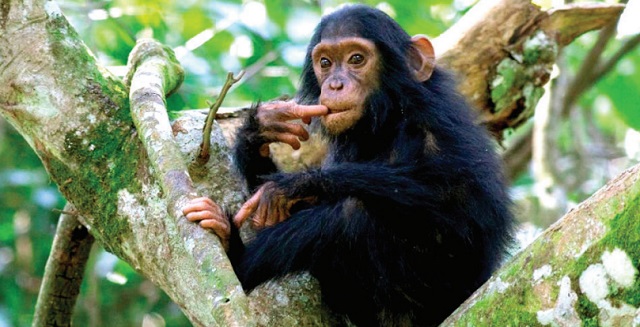
How communities who regard the animal as a totem are saving it
Kampala, Uganda | RONALD MUSOKE | Agnes Nyangoma Mukooto, an elderly grandmother in Kabwoya, a quiet sleepy village near the shores of Lake Albert in mid-western Uganda, grew up listening to her father tell stories about the totem of their clan; the chimpanzee.
Her favourite was the one about how the flat-faced apes that resemble a human being were once members of her clan; the Basiita of Bunyoro. The way her father told the story, chimpanzees everywhere today are the lost brothers and sisters of the Basiita; they ran away to live in forest to evade paying taxes.
Mukooto says she developed an enduring love for the chimpanzee from listening to her father’s folk stories and today also tells them to her grandchildren.
One of them is Simon Kunihira.
For him, the best story is the one which involved a chimpanzee, a woman, her baby and her husband. He says it is the most popular in his village.
Long time ago, he tells the story, there was a woman who used to go to work in the garden on the edge of a nearby forest. Every day, she would go till the garden with her husband and her baby strapped on her back. Sadly, one day, the woman died mysteriously.
She had not gone with her husband to the garden that day as she usually did. Hours passed without anyone rescuing the baby and the baby started crying. When a chimpanzee which used to live in the nearby forest heard the distressed baby’s cry, it picked and climbed up the tree with the baby.
Hours later when villagers came to pick the woman’s body, the people saw the chimpanzee with the baby on her lap. The people were stunned and wanted to rescue the baby but the chimpanzee refused to budge. It only released the baby when the woman’s husband arrived. It identified him because it used to see him with the mother of the baby in the garden.
“When this story was told to us,” Kunihira says “I started believing that it is actually true that chimpanzees share with us 98.4% of the DNA.”
Luckily, Mukooto and her family have a 29 hectare forest in Kabwoya which they have owned for over 40 years. She says her family has partly been inspired to keep the forest because of their totem—the chimpanzee.
“Over the years, we noticed two chimpanzees that frequented our forest searching for food. So, we decided to plant sugarcane especially for the chimpanzees, as well as fruits and indigenous trees to enrich the forest,” Mukooto, a diminutive middle aged woman with a commanding voice says.
Kunihira and his grandmother retold the stories at a recent forum organised by the Cross Cultural Foundation of Uganda (CCFU), a Kampala-based non-profit that promotes the appreciation of Uganda’s cultural identity and diversity. The forum was called to share research findings from a two year study on chimpanzee conservation using culture.
It brought together conservationists, cultural leaders and private forest owners mostly from the Albertine region in western Uganda to dialogue on the importance of culture in community conservation.
George Owoyesigire, the deputy director of community conservation at the Uganda Wildlife Authority (UWA) says because chimpanzees are our closest relatives; sharing 98.4% of DNA, “It is not surprising that they have similar emotions with humans.”
“If you annoy a chimpanzee; you fight it, beat it or kill its young ones, it is likely that it will revenge,” he says, “Chimpanzees can play, they can kiss like us, they can also hug and they can laugh like us; meaning that they are indeed our closest relatives.”
“Are they endangered? Yes they are and this means that they are likely to disappear forever if we do not take appropriate action,” he says.
He says a chimpanzee census is needed but there is a hunch that their populations are under threat from humans.
“Their populations could be declining from over 10,000 to 5, 000,” he says.
The last census carried out around 2002 also registered the same number of 5000. They are primarily found in large forests but they also live in Kibaale National Park (25%) while others live outside parks and reserves in Kagadi, Kakumiro, Kyenjojo, Kabarole, Hoima, Kikuube, Kibaale and Masindi districts in western Uganda. Some chimpanzees have been sighted in the northwestern forest of Otzi.
Owoyesigire says research recently done around Kibaale National Park in western Uganda shows negative effects of climate change on the chimpanzees’ ability to find food.
“Trees which used to fruit around January no longer do so. And as such, the chimpanzees have to go into the gardens of the frontline communities to search for food,” he says.
This fuels the escalating tension between the people in Bunyoro and the chimpanzees. It is now not easy to be a private forest owner in the area.
“Private forest owners particularly need support to help them keep the habitat for these chimpanzees,” says Dr. Pantaleon Kasoma, the Board Chairperson at the Uganda Wildlife Authority.
 The Independent Uganda: You get the Truth we Pay the Price
The Independent Uganda: You get the Truth we Pay the Price





